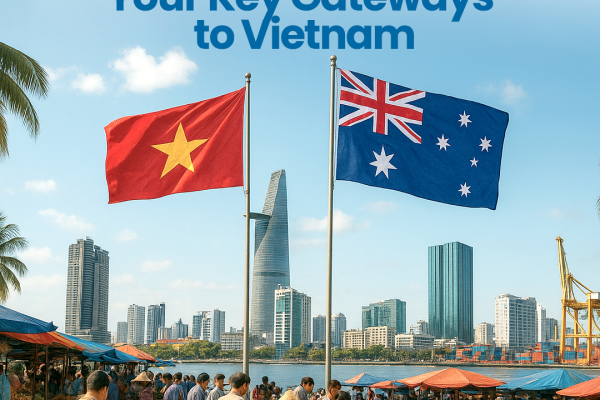The Australia-Vietnam relationship has never been stronger. Last year, the Prime Ministers of both countries agreed to a Joint Statement on the elevation to a Comprehensive Strategic Partnership between the two.
When trading with Vietnam, expect competition, potential logistical challenges, and be prepared for a business culture that values personal relationships and can lead to lengthy negotiations.
You should also keep in mind its strong trade relationship with the United States – its largest export market – and its participation in several free trade agreements that offer advantages to countries like Australia.
We do not have a direct bilateral Free Trade Agreement (FTA) with Vietnam but Australia has access through multiple deals, including the Comprehensive and Progressive Agreement for Trans-Pacific Partnership (CPTPP), the Regional Comprehensive Economic Partnership (RCEP), and the ASEAN–Australia–New Zealand Free Trade Agreement (AANZFTA). These agreements reduce or eliminate trade barriers between the two countries.
Exporters need to be aware that there are changes to the Rules of Origin requirements for Vietnam under the AANZFTA agreement as from this month. Ask us here at Colless Young for the new AANZFTA Certificate of Origin template.
Our bilateral trading relationship with Vietnam is one of Australia’s fastest growing in recent years. In 2024, two-way trade was valued at $28.8 billion. Key Australian exports to Vietnam include coal, gold, and agricultural products, while Vietnam’s main exports to Australia are textiles, electronics, and machinery.
The major shipping ports in Vietnam are Ho Chi Minh City (Saigon) Port in the south and Hai Phong Port in the north, with Da Nang Port also being a key regional hub in the central part of the country.
Ho Chi Minh City
Saigon Port / Ho Chi Minh City Port System: Situated in the south of the country, this port is the largest in Vietnam, playing a crucial role in and around Ho Chi Minh City (HCM), and as a transportation hub for the Southeast region and the Mekong Delta. It handles the highest volume of the country’s international container traffic. HCM encompasses several major terminals, such as the Cat Lai Port, which is the largest and most modern international container port in Vietnam. It has five port areas with a total area of 36,06 hectares.
The major cargo airport in HCM is Tan Son Nhat International Airport (SGN).
Long Thanh International Airport, currently under construction, will be a new international hub with significant cargo capacity in future.
Hanoi
Hai Phong Port: Situated in the north, this is the second-largest port and a vital hub for exports from Hanoi and the surrounding region, handling a massive volume of international container traffic. It is ranked among the world’s top container ports, and boasts a new island port area (Lạch Huyện) located to the east of the city.
The main airport for airfreight in Hanoi is Noi Bai International Airport (HAN).
Da Nang Port:
While smaller than the other two, Da Nang is an important regional port for central Vietnam, connecting it to other countries like Laos and Thailand.
Vietnam is committed to trade liberalisation through participation in APEC (which it hosted in 2017 and will host again in 2027), ASEAN, the World Trade Organization and a growing network of free trade agreements. In addition to AANZFTA, the CPTPP, and the RCEP mentioned above, Australia and Vietnam are also working together through the Indo-Pacific Economic Framework (IPEF). Vietnam is a member of the Cairns Group of agricultural exporting countries.
Personal relationships are crucial in Vietnamese business culture, and introductions from a trusted third party are not only highly valued, but often necessary to establish business dealings. Make sure you get it right from the outset by talking to Colless Young when you are ready to start shipping. Call Andrew, Tel: +61 7 3890 0800 email enq@collessyoung.com.au

